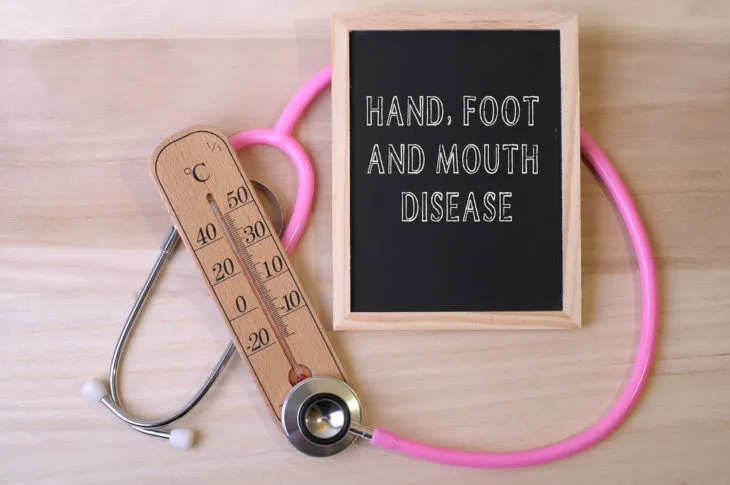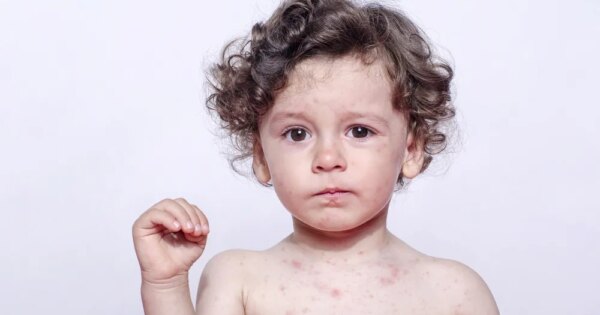While this disease is considered mild, at least by the Mayo Clinic, it doesn’t make it pleasant. The contagious condition is common in children (especially when they’re regularly in a social setting like a daycare), adds the source, and is most commonly caused by a coxsackie virus. In fact, some doctors will refer to the illness as the virus name.
The clinic says symptoms can vary depending on what stage the disease is on, but it usually doesn’t last very long overall (about a week or so usually). In some rarer cases, symptoms can become more severe, so keep an eye on them. Here are seven things to know about this disease, which can be more common in the fall…
1. Fever First
The Mayo Clinic says that the first sign of hand, foot and mouth disease is often a fever, followed by other symptoms such as a sore throat and a loss of appetite or general feeling of not being well.
The clinic notes that the other symptoms will usually show up 1 or 2-days after the fever starts, and that the fever itself generally will last a few days. Of course, a fever can be tied to many other illnesses, so perhaps consult a doctor if symptoms don’t improve.
2. Rash Follows
As the name of the disease suggests, a rash can appear on the hands and feet, but also on the buttocks, notes WebMD. “And while it’s not pleasant, it also isn’t serious,” assures the source.
WebMD notes your child may get a rash on the palms of the hands or soles of the feet 1 or 2-days after the first symptoms appear (which, as we’ve already mentioned, will probably be a fever). The rashes may worsen and turn into blisters, and you might notice sores on the knees and elbows, it adds.
3. Mouth Sores
KidsHealth.org talks about the other part of the illness’s namesake, noting “painful red blisters” can appear in the mouth and throat. In some cases, kids will have no skin signs of the disease other than sores in the back of the throat, it adds.
There could be other symptoms related to having pain in the mouth and throat. For example, the source explains your child may drool (due to painful swallowing) and may become more partial to only cold fluids.
4. Ulcers Only
The Women’s and Children’s Health Network (government of South Australia) reminds us that hand, foot and mouth disease is primarily a children’s disease. This is because “most adults will have had the infection in childhood” and will likely not experience it again later in life.
However, if the virus does reappear in adults, it’s usually contained to ulcers in the mouth rather than the rash on the hands and feet, adds the source.
5. More Severe Symptoms
The Seattle Children’s Hospital confirms there is a more severe version of the disease that became more prominent around the world in 2012 as a result of a “new” Coxsackie A6 virus.
In this case, the rash can spread onto the arms, legs and face, “made up of many small blisters,” it explains. Skin peeling may occur – “It looks bad but is harmless,” adds the source, noting a skin moisturizer on the raw areas can help. Fingernails and toenails can fall off in some cases, but only in about 4-percent of the severe cases, it adds.
6. Limited Treatments
The Centers for Disease Control and Prevention (CDC) explains there is no specific treatment for this illness, although you can help relieve your child’s symptoms. It suggests over-the-counter pain relievers (but reminds that aspirin should not be given to children).
You can also use mouthwash or sprays (or even chew on ice chips) that help numb the mouth if there’s a lot of pain in the mouth and throat region, it adds. If these non-prescription methods don’t provide any relief, then you should contact your healthcare provider, it adds. Also make sure your child stays hydrated.
7. Preventative Measures
Of course, as with any disease, the best way to beat hand, foot and mouth disease is by avoiding getting it in the first place (which is easier said than done). You can avoid catching the disease by not touching the blisters or stool of a child that you know to be infected, explains MedicinePlus.gov.
To help prevent your little one from passing the disease along to their friends, you should keep them home from daycare until the fever is gone (usually around 2 or 3-days). However, if there’s many blisters still visible, you should avoid letting your child go to school until they dry up – usually around 7-days, says the Seattle Children’s Hospital.




